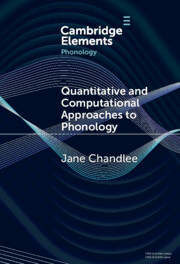Refine search
Actions for selected content:
198 results
Chapter 22 - The Music of Philosophy in Late Antiquity
- from Part IV - Mathematics
-
- Book:
- The Ladder of the Sciences in Late Antique Platonism
- Print publication:
- 08 January 2026, pp 294-309
-
- Chapter
- Export citation
Chapter 9 - Patterns of Perfection in Damascius’ Life of Isidore
- from Part II - Ethics
-
- Book:
- The Ladder of the Sciences in Late Antique Platonism
- Print publication:
- 08 January 2026, pp 124-139
-
- Chapter
- Export citation
Chapter 8 - Ancient Biographies of Pythagoras and Epicurus as Models of the Philosophical Life
- from Part II - Ethics
-
- Book:
- The Ladder of the Sciences in Late Antique Platonism
- Print publication:
- 08 January 2026, pp 113-123
-
- Chapter
- Export citation

Modelling the Divine
-
- Published online:
- 05 December 2025
- Print publication:
- 08 January 2026
-
- Element
- Export citation
Metabolic considerations for cognitive modeling
-
- Journal:
- Behavioral and Brain Sciences / Accepted manuscript
- Published online by Cambridge University Press:
- 18 November 2025, pp. 1-53
-
- Article
-
- You have access
- Export citation
1 - The Big Picture of Analytics Science
-
- Book:
- Insight-Driven Problem Solving
- Published online:
- 21 October 2025
- Print publication:
- 30 October 2025, pp 12-52
-
- Chapter
- Export citation
17 - Christology and Metaphysics
- from Part IIIb - Christology and Philosophical Theology
-
-
- Book:
- The Cambridge Companion to Christology
- Published online:
- 15 September 2025
- Print publication:
- 02 October 2025, pp 287-304
-
- Chapter
- Export citation
Chapter 13 - Social Anxiety Disorder
- from Part III - Application and Adaptations for Mental Health Presentations
-
-
- Book:
- Cambridge Guide to Cognitive Behavioural Therapy (CBT)
- Published online:
- 18 November 2025
- Print publication:
- 18 September 2025, pp 120-140
-
- Chapter
- Export citation
Chapter 12 - Panic Disorder
- from Part III - Application and Adaptations for Mental Health Presentations
-
- Book:
- Cambridge Guide to Cognitive Behavioural Therapy (CBT)
- Published online:
- 18 November 2025
- Print publication:
- 18 September 2025, pp 104-119
-
- Chapter
- Export citation
Methods used in early value assessments for nice: a scoping review
-
- Journal:
- International Journal of Technology Assessment in Health Care / Volume 41 / Issue 1 / 2025
- Published online by Cambridge University Press:
- 08 September 2025, e64
-
- Article
-
- You have access
- Open access
- HTML
- Export citation
2 - Law’s Response to Disfigurement Inequality
-
- Book:
- Appearance, Disability and the Law
- Published online:
- 31 July 2025
- Print publication:
- 14 August 2025, pp 10-26
-
- Chapter
- Export citation
Chapter 2 - Physics
-
-
- Book:
- On Discovery
- Published online:
- 05 May 2025
- Print publication:
- 22 May 2025, pp 20-34
-
- Chapter
- Export citation
Calibration of transition probabilities to model survival of adjuvant trastuzumab for early breast cancer in Indonesia
-
- Journal:
- International Journal of Technology Assessment in Health Care / Volume 41 / Issue 1 / 2025
- Published online by Cambridge University Press:
- 26 March 2025, e18
-
- Article
-
- You have access
- Open access
- HTML
- Export citation
Chapter 5 - Neurobiology of Mental Disorders
-
-
- Book:
- Fundamentals of Clinical Psychiatry
- Published online:
- 02 January 2025
- Print publication:
- 16 January 2025, pp 27-38
-
- Chapter
- Export citation
Working memory structure in young Spanish–English bilingual children
-
- Journal:
- Bilingualism: Language and Cognition / Volume 28 / Issue 2 / March 2025
- Published online by Cambridge University Press:
- 13 December 2024, pp. 469-483
-
- Article
-
- You have access
- Open access
- HTML
- Export citation

Quantitative and Computational Approaches to Phonology
-
- Published online:
- 05 December 2024
- Print publication:
- 16 January 2025
-
- Element
- Export citation
11 - The Present Situation in Quantum Mechanics
-
- Book:
- The Einstein Paradox
- Published online:
- 14 November 2024
- Print publication:
- 28 November 2024, pp 175-207
-
- Chapter
- Export citation
9 - Worse Than Useless
- from Part II - Economics
-
- Book:
- Five Times Faster
- Published online:
- 24 October 2024
- Print publication:
- 07 November 2024, pp 99-108
-
- Chapter
- Export citation
Experimental and theoretical studies of the interactions of alanine onto surfaces of olivine and montmorillonite: relevance in astrobiology
-
- Journal:
- International Journal of Astrobiology / Volume 23 / 2024
- Published online by Cambridge University Press:
- 08 October 2024, e19
-
- Article
-
- You have access
- Open access
- HTML
- Export citation
Chapter 1 - What Is Ecology in Action?
- from Part I - Introduction and the Physical Environment
-
- Book:
- Ecology in Action
- Published online:
- 04 April 2024
- Print publication:
- 04 July 2024, pp 2-19
-
- Chapter
- Export citation
